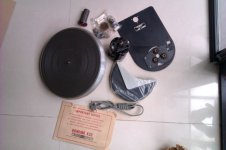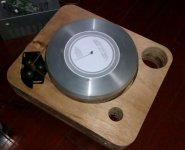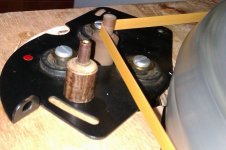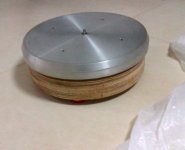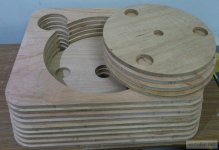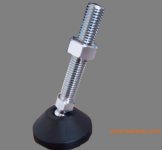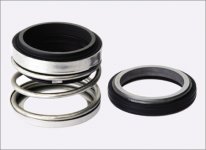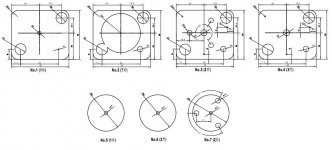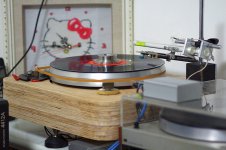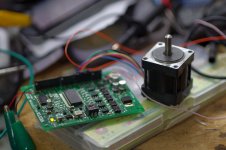I got a vintage TT kit form ebay 2 months ago.The AC motor is strong and it's vibration is a bit high in running,so I decided to design a suspended base to reduce the vibration influence on platter.
The base material is thick plywood,I cut the pieces by CNC machine according CAD designed profile.Three mechanical seals will be set between motor base and platter base.The mechanical seal is special sealing unit for pump.I choose 3 Universal shock absorber feet for motor base support.
I rebuilt the motor Pulley for 50HZ power supply using same material,the testing speed is steady and accurate.
Here are some pics of this DIY.This TT Is not completed yet,I will fix my DIY glass tube LT to test it. to be continued....
The base material is thick plywood,I cut the pieces by CNC machine according CAD designed profile.Three mechanical seals will be set between motor base and platter base.The mechanical seal is special sealing unit for pump.I choose 3 Universal shock absorber feet for motor base support.
I rebuilt the motor Pulley for 50HZ power supply using same material,the testing speed is steady and accurate.
Here are some pics of this DIY.This TT Is not completed yet,I will fix my DIY glass tube LT to test it. to be continued....
Attachments
Last edited:
Hi!dtut,thank you for your reply.I've finished this TT and played some vinyls with my DIY glass tube LT tonearm.The sound is nice but the vibration influence,the cartridge amplify the micro vibration,especially between the blank of two songs. I can not completely remove the influence.So I have to separate motor support or replace the AC motor by micro step motor.Do you have another idea about this?
attached Pics are the finished TT and Step motor kit
attached Pics are the finished TT and Step motor kit
Attachments
replace the motor support or replace to a micro-stepper...
I would suggest that you seek help from some that have good success with idlers (not a dis to dtut, hi doug ). But AFAIK you might find new motor grommets to be a good place to begin. The Rek-O-Kut idlers have a huge fan base, and I'm sure someone over at Lenco Heaven may be able to help you out (Lenco Heaven is expanding and deals with more than just Lenco turntables). Idlers are so expensive here that I've pretty much resigned myself to scabbing together my own out of Dual or Garrard changers (gutted).
). But AFAIK you might find new motor grommets to be a good place to begin. The Rek-O-Kut idlers have a huge fan base, and I'm sure someone over at Lenco Heaven may be able to help you out (Lenco Heaven is expanding and deals with more than just Lenco turntables). Idlers are so expensive here that I've pretty much resigned myself to scabbing together my own out of Dual or Garrard changers (gutted).
I would suggest that you seek help from some that have good success with idlers (not a dis to dtut, hi doug
Interesting project.
I think I see that the TT platter assembly sits on the same base that the motor is mounted to??
Also I do not quite see the arm mounting arrangment.
From what I can see it is an error to mount the original motor to the wood base by direct means. The wood acts like a transmission medium for the motor's vibration, somewhat of an amplifier. I see you have spring decouplers under the TT platter? They may not isolate sufficiently.
It would be best to have the motor physically isolated, not even mounted to the same base as the arm or the platter.
I am not a fan of servo motors to run turntables. They are not quiet, and present other issues. Otoh, it is possible to use it.
If it were my project I would remachine the area where the motor is mounted and re-think that whole idea of mounting the motor to the base directly. It is better to have it stand on its own. Perhaps a weighted "pod".
Done this way: two or three separate parts; turntable + base, arm (either on TT base or floating pod), and motor "pod" assembly, those elements still need a surface to sit upon and then your focus changes to the proper method to isolate, damp and control that surface.
One of the cheapest ways to handle that is a simple sandbox.
You just make a sandbox with 1"-4" of fine, clean sand and your two or three elements sit on the sand! Of course if you *want* coupling then you can put a flat material under them - say the TT base and the arm pod sit on a slab of wood, metal, corian, plastic, etc... for example. The motor can sit on a separate surface on top of the sand. Almost perfect isolation.
Of course there is whatever comes down the belt to the platter...
Hope this helps...
_-_-bear
I think I see that the TT platter assembly sits on the same base that the motor is mounted to??
Also I do not quite see the arm mounting arrangment.
From what I can see it is an error to mount the original motor to the wood base by direct means. The wood acts like a transmission medium for the motor's vibration, somewhat of an amplifier. I see you have spring decouplers under the TT platter? They may not isolate sufficiently.
It would be best to have the motor physically isolated, not even mounted to the same base as the arm or the platter.
I am not a fan of servo motors to run turntables. They are not quiet, and present other issues. Otoh, it is possible to use it.
If it were my project I would remachine the area where the motor is mounted and re-think that whole idea of mounting the motor to the base directly. It is better to have it stand on its own. Perhaps a weighted "pod".
Done this way: two or three separate parts; turntable + base, arm (either on TT base or floating pod), and motor "pod" assembly, those elements still need a surface to sit upon and then your focus changes to the proper method to isolate, damp and control that surface.
One of the cheapest ways to handle that is a simple sandbox.
You just make a sandbox with 1"-4" of fine, clean sand and your two or three elements sit on the sand! Of course if you *want* coupling then you can put a flat material under them - say the TT base and the arm pod sit on a slab of wood, metal, corian, plastic, etc... for example. The motor can sit on a separate surface on top of the sand. Almost perfect isolation.
Of course there is whatever comes down the belt to the platter...
Hope this helps...
_-_-bear
Last edited:
not the best choice...
7.5 degree steppers are essentially 48 pole AC synchronous motors when driven by a PWM signal or a sine/cosine wave pair. See: Altmann DIY Turntable for some details.Using the small low power steppers is superior to using an industrial (square flanged) stepper. Need more power? Add a motor or two...
regarding bear's post:I agree with bear's comments. Sorry eaglebear, I assumed you were using an original top plate. Yes, the motor should be mounted on it's own, and the sandbox is a good idea. The bearing and the tonearm need to be rigidly mounted to the same object so that it reduces the degrees of freedom between them. I guess a pod (heavy) could be used for the tonearm as long as both the platter housing/plinth and tonearm pod are heavy enough and coupled to the same object so that they do not move in relation to one another.
I know there is one Rega modifier out there who makes an isolation motor mount for those turntables and it is apparently startlingly good. I must believe something similar for the K-33 would work. Then make a 1/4" tape drive belt (or 1/2" if you have a pulley...)
"micro step motor" not the best choice for driving a turntable.
Look for an AC sync, DC brush or DC brushless motor.
7.5 degree steppers are essentially 48 pole AC synchronous motors when driven by a PWM signal or a sine/cosine wave pair. See: Altmann DIY Turntable for some details.Using the small low power steppers is superior to using an industrial (square flanged) stepper. Need more power? Add a motor or two...
regarding bear's post:I agree with bear's comments. Sorry eaglebear, I assumed you were using an original top plate. Yes, the motor should be mounted on it's own, and the sandbox is a good idea. The bearing and the tonearm need to be rigidly mounted to the same object so that it reduces the degrees of freedom between them. I guess a pod (heavy) could be used for the tonearm as long as both the platter housing/plinth and tonearm pod are heavy enough and coupled to the same object so that they do not move in relation to one another.
I know there is one Rega modifier out there who makes an isolation motor mount for those turntables and it is apparently startlingly good. I must believe something similar for the K-33 would work. Then make a 1/4" tape drive belt (or 1/2" if you have a pulley...)
EB,
Nanook is right (Good evening, Stew) I'm not the most experienced idler guy around since I just got my L-34 up and running, but since the K-33 is a belt drive, I think it's more like an Empire than a classic idler, anyway. I think something important to remember is that Empire and ROK are very simple, very carefully made machines and, I think, that's a good foundation if you want to build a TT based on either of them.
As Nanook suggests, getting new motor mounts is a good idea even if the ones you have look OK. They're cheap and can make a big difference.
The motor you have is the same one I have and it's actually pretty good, but it may be you'll have to take it apart and clean it and re-oil the bearings. Mine vibrated badly when I first got it. Cleaning and re-lubing took care of that and it runs quiet and smooth, now. The K-33H came with a Pabst hysteresis motor, which is superb. You might try to find one if you really want to change motors. I've never heard a K-33, but a properly set up Empire, which has the same motor mount system, doesn't transmit any motor noise to the platter or stylus.
A mechanics' stethoscope will help you detect and trace noise. Take the belt off and just run the motor. Spin the platter. Put the belt back on and run the platter with the motor. Do you hear anything any any stage?
Did you clean and polish the platter shaft and bearing walls? Did you check/replace the ball bearing at the bottom of the well? Any wear or dirt can be audible.
Register at Vinyl Engine and download a K-33 service manual. It's free and full of great information. Check out Audio Karma Turntables for good information from people who have built TTs from ROKs and Empires.
If you look at the original capstan - the drive pulley on the motor - you'll notice it's barrel shaped. That keeps the belt centered. It looks to me like the capstan you machined is straight sided and that's why the belt isn't centered. As it is, the lower edge of the belt is riding on the capstan shoulder and that can cause noise that can be transmitted to the platter and stylus. I've had that happen. Also, pictures of the K-33 show the belt running in the middle of the platter edge. If that is an original belt, it may be stiff and a new belt would be a good idea. I tried a 1/4 inch tape belt on an Empire and it ran fast because tape is too thin.
You have a lot of design and machining talent and I think you'll be fine if you think of this as a restoration project first - get the K-33 parts working right - maybe even try a simpler, more traditional plinth to get familiar with the basics. Your TT design is a bit unorthodox, but that's no big deal - so are LTs.
I wish you good luck with this project because I still want to know what you think of your LT on your TT. If I've wasted your time with a bunch of stuff you already know, I apologize.
Nanook is right (Good evening, Stew) I'm not the most experienced idler guy around since I just got my L-34 up and running, but since the K-33 is a belt drive, I think it's more like an Empire than a classic idler, anyway. I think something important to remember is that Empire and ROK are very simple, very carefully made machines and, I think, that's a good foundation if you want to build a TT based on either of them.
As Nanook suggests, getting new motor mounts is a good idea even if the ones you have look OK. They're cheap and can make a big difference.
The motor you have is the same one I have and it's actually pretty good, but it may be you'll have to take it apart and clean it and re-oil the bearings. Mine vibrated badly when I first got it. Cleaning and re-lubing took care of that and it runs quiet and smooth, now. The K-33H came with a Pabst hysteresis motor, which is superb. You might try to find one if you really want to change motors. I've never heard a K-33, but a properly set up Empire, which has the same motor mount system, doesn't transmit any motor noise to the platter or stylus.
A mechanics' stethoscope will help you detect and trace noise. Take the belt off and just run the motor. Spin the platter. Put the belt back on and run the platter with the motor. Do you hear anything any any stage?
Did you clean and polish the platter shaft and bearing walls? Did you check/replace the ball bearing at the bottom of the well? Any wear or dirt can be audible.
Register at Vinyl Engine and download a K-33 service manual. It's free and full of great information. Check out Audio Karma Turntables for good information from people who have built TTs from ROKs and Empires.
If you look at the original capstan - the drive pulley on the motor - you'll notice it's barrel shaped. That keeps the belt centered. It looks to me like the capstan you machined is straight sided and that's why the belt isn't centered. As it is, the lower edge of the belt is riding on the capstan shoulder and that can cause noise that can be transmitted to the platter and stylus. I've had that happen. Also, pictures of the K-33 show the belt running in the middle of the platter edge. If that is an original belt, it may be stiff and a new belt would be a good idea. I tried a 1/4 inch tape belt on an Empire and it ran fast because tape is too thin.
You have a lot of design and machining talent and I think you'll be fine if you think of this as a restoration project first - get the K-33 parts working right - maybe even try a simpler, more traditional plinth to get familiar with the basics. Your TT design is a bit unorthodox, but that's no big deal - so are LTs.
I wish you good luck with this project because I still want to know what you think of your LT on your TT. If I've wasted your time with a bunch of stuff you already know, I apologize.
Bear,Thanks a lot,Great suggestion!Just like what you think,I use one base to support all units including motor,platter and tonearm,the original damping structure can not damp the vibration completely.So an physical isolated motor base is quite necessary,I will cut the motor part form base and rebuild motor support increasing mass with sand.Hope it will be effective.Interesting project.
...
Hope this helps...
_-_-bear
Hi,Nanook7.5 degree steppers...
My stepper motor kit's type is VEXTA PMD03C+PMM33A2-C11,5 poles,0.72 degree every step,the top speed can be 3000 rpm.I tested it with square wave,it worked smoothly and strong.The only problem is the noise need to be isolated by a sealed metal box.One more motor can improve the operating stability.My next modification is on the base ,not the motor.
I'm using a part of top plate to fix motor,the plate is too thin and light to damp motor vibration.I will rebuilt the base referencing bear's and yours suggestion.
Dtut, nice to see your helpful replay again.Stethoscope is an useful tool to trace noise,I'll try it.I run the motor without belt and put stylus on vinyl’s blank track,the amplified vibration noise is a bit obvious.If running with belt, the noise will be louder and mixing with tracking noise because the motor vibration increased on load.Maybe I select wrong material to build the base,the plywood's density is too small to get enough mass damping vibration.EB,
A mechanics' stethoscope will help you detect and trace noise. Take the belt off and just run the motor. Spin the platter. Put the belt back on and run the platter with the motor. Do you hear anything any any stage?
Did you clean and polish the platter shaft and bearing walls? Did you check/replace the ball bearing at the bottom of the well? Any wear or dirt can be audible.
This TT kit is new and in good storage condition, basically no corrosion,no oxides and no aging on rubber units .I added some lubricating oil in platter shaft and all bearings.The motor run smoothly and silently,and I can feel the vibration while hand holding it.The vibration is higher than stepper motor.The placed platter can keep running for more than 2 minutes if turned by hand.
The pulley sharp was ignored,I will re-machine it,thank you for this key point. I am very happy to discuss TT and LTT DIY with you,I will show some playing video if the noisy is completely removed.
-----eagle bear
"7.5 degree steppers are essentially 48 pole AC synchronous motors when driven by a PWM signal or a sine/cosine wave pair. See: Altmann DIY Turntable for some details.Using the small low power steppers is superior to using an industrial (square flanged) stepper. Need more power? Add a motor or two..."
Interesting, thanks. I will try this, but what is the advantage to use a micro stepper over a traditional sync motor running on 50/60Hz? Or a DC servo motor salvaged from an old cassette player.
Interesting, thanks. I will try this, but what is the advantage to use a micro stepper over a traditional sync motor running on 50/60Hz? Or a DC servo motor salvaged from an old cassette player.
eaglebear, sand is a way to add mass to an object, like filling the bottom of a can or box... the sand I was talking about is a base or platform that the entire setup sits on top of. A big tray filled with sand, on top of which you place a flat surface, and on top of that goes your turntable... Now, you can separate the motor from the turntable itself by making it sit on a separate smaller platform on top of the sand. This gives excellent isolation.
For example, the smaller platform for the motor could be a 1" thick piece of steel, say 6" or so diameter (for mass and stability) or just wood, but with a heavy box or can that is even sand filled that holds the motor.
Hope this description is clear enough?
Seems to me that Nanook said that square wave driven steppers are not such a good idea - drive with sinewaves, to eliminate the noise issue... that's what he said.
The simpler sinewave two phase drive system can be built with less trouble, and Altman suggests using a computer with a sound editing program to produce sinewaves of some exact frequency and exact phase shift. You output that line level signal to some little audio amplifier to driver the stepper motor with power... a bit of a kludge, but you could just dump that file to a silly cheapo MP3 player and use a cheap little commercial class D amp and have it all running perfectly in a tiny space and at low cost...
I think I know how to do this even more simply but I have to do some research and look for a particular chip that is intended for other duties that I seem to recall existing. One would still need a stable sinewave source at the right frequency...
Hmmm... glad I read this thread!
_-_-bear
For example, the smaller platform for the motor could be a 1" thick piece of steel, say 6" or so diameter (for mass and stability) or just wood, but with a heavy box or can that is even sand filled that holds the motor.
Hope this description is clear enough?
Seems to me that Nanook said that square wave driven steppers are not such a good idea - drive with sinewaves, to eliminate the noise issue... that's what he said.
The simpler sinewave two phase drive system can be built with less trouble, and Altman suggests using a computer with a sound editing program to produce sinewaves of some exact frequency and exact phase shift. You output that line level signal to some little audio amplifier to driver the stepper motor with power... a bit of a kludge, but you could just dump that file to a silly cheapo MP3 player and use a cheap little commercial class D amp and have it all running perfectly in a tiny space and at low cost...
I think I know how to do this even more simply but I have to do some research and look for a particular chip that is intended for other duties that I seem to recall existing. One would still need a stable sinewave source at the right frequency...
Hmmm... glad I read this thread!
_-_-bear
The requirements for such motor beside the steady speed are the noiseless , vibration less operation. Both can be had in a simple 120 or 220V synchronous motor. Problem arises only if the AC line frequency is not stable, which is not the case in Europe or here in N.America.
bear,thank you for your detail description,I got it!
miklos,normally the stepper motor's torque is far largger than ac motor in same size,and driving frequency is higher,so the sympathetic viberation frequency is higher also and need lower mass base for damping.Another advantage is the control precision.Dc servo motor is not blushless,the operating life and EMC have to be concidered.
miklos,normally the stepper motor's torque is far largger than ac motor in same size,and driving frequency is higher,so the sympathetic viberation frequency is higher also and need lower mass base for damping.Another advantage is the control precision.Dc servo motor is not blushless,the operating life and EMC have to be concidered.
advantage of a 7.5 degree stepper...
... is I think the available at very low prices. I paid $2 ea. for a half dozen...
... and are easy to control. Just use items recommended for 50 or 60 Hz operation and you're set (the signal frequency can be varied for use as a speed control). The benefit is that the speed can be tightly controlled and varied so that if there is a mismatch between the platter and the pulley/motor, there is an adjustment that can be made. I would also recommend the use of a laser tachometer to verify the accuracy of the speed. The closest I get to a 33 1/3 RPM reading on my Oracle is to within .01 RPM (33.34 RPM, which I can live with), so accuracy is +/-.005 RPM or about .015%. Try measuring that accuracy with anything else except a frequency counter and a test record. I'd also suggest testing the speed while playing a record if using a laser tach.
EB: "True, but they tend to have less torque, or so I am let to believe - although I suppose one can find synchronous motors in larger sizes, the typical small clock motor size are a bit anemic, yes? "
The ones I found were used in a photocopier (IIRC), not a clock .
.
Interesting, thanks. I will try this, but what is the advantage to use a micro stepper over a traditional sync motor running on 50/60Hz? Or a DC servo motor salvaged from an old cassette player.
... is I think the available at very low prices. I paid $2 ea. for a half dozen...
... and are easy to control. Just use items recommended for 50 or 60 Hz operation and you're set (the signal frequency can be varied for use as a speed control). The benefit is that the speed can be tightly controlled and varied so that if there is a mismatch between the platter and the pulley/motor, there is an adjustment that can be made. I would also recommend the use of a laser tachometer to verify the accuracy of the speed. The closest I get to a 33 1/3 RPM reading on my Oracle is to within .01 RPM (33.34 RPM, which I can live with), so accuracy is +/-.005 RPM or about .015%. Try measuring that accuracy with anything else except a frequency counter and a test record. I'd also suggest testing the speed while playing a record if using a laser tach.
EB: "True, but they tend to have less torque, or so I am let to believe - although I suppose one can find synchronous motors in larger sizes, the typical small clock motor size are a bit anemic, yes? "
The ones I found were used in a photocopier (IIRC), not a clock
- Status
- This old topic is closed. If you want to reopen this topic, contact a moderator using the "Report Post" button.
- Home
- Source & Line
- Analogue Source
- Design a suspended TT with REKOKUT KIT
